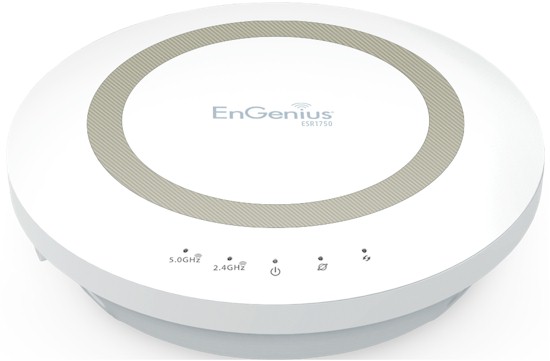
| At a glance | |
|---|---|
| Product | EnGenius Dual Band Wireless AC1750 Router (ESR1750) [Website] |
| Summary | QCA-based AC1750 class router with Gigabit ports, USB 2.0 storage sharing and VPN servers. |
| Pros | • Good FAT32 storage performance • PPTP, L2TP and IPsec VPN Servers • IPv6 support • 4 SSIDs per band |
| Cons | • Unimpressive 2.4 Ghz and 5 GHz range • No bridging / repeating • Not Wi-Fi Certified |
Typical Price: $120 Buy From Amazon
Introduction
Updated 10/2/2013: Corrected internal component information
Several weeks ago, we reviewed the EnGenius ESR1200. We concluded that the ESR1200, priced slightly higher than competing AC1200 class routers, had little to recommend it, other than its built-in IPSec, L2TP over IPSec, L2TP and PPTP VPN servers. In this review, we’ll take a look at the top-of-line AC1750 class EnGenius ESR1750.
One of the most interesting discoveries about the ESR1200 was that it uses the identical hardware found in the ESR1750. EnGenius just locked the link rates on the ESR1200 to make it operate as an AC1200 class router. Both routers share the same FCC ID (A8JESR900), so you know that the internal components have to be the same.
Not surprisingly, the ESR1750 callout diagram below is virtually identical to the one for the ESR1200. The only difference is the model number printed in the center. One thing to note: If you like LED link and activity indicators, you’re going to be disappointed. There are no link or activity indicators for any of the wired ports.
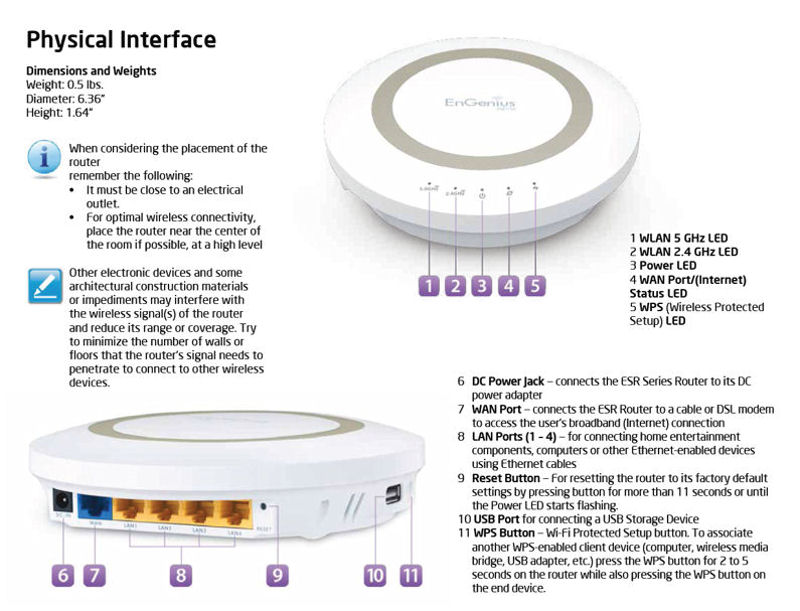
EnGenius ESR1750 rear panel and top callouts
In his ESR1200 review, Scott did a great job of exploring all of the features and internal components, so refer back to his review for that content. For the sake of completeness, I’ll reiterate just a few items from his review. But for the most part, this review will focus on the performance of the ESR1750. As expected, the ESR1750 outperformed the ESR1200, but its performance placed it at the bottom of the Router Ranker for AC1750 class routers.
Inside
Updated 10/2/2013: Corrected internal component information
We often use the FCC certification documents for our inside circuit board photos. It turns out, that was a bad idea because the actual products are very different from the product shown in the FCC ID internal photos.
The image below is a photo of the actual ESR1750 board from the reviewed sample. The 5 GHz radio is on a mini PCIe board instead of integrated directly into the main board as shown in the FCC filing. The switch chip is different than originally identified and so is the 5 GHz radio. At least the QCA9558 dual-band, 3-stream 802.11n system-on-chip was properly identified.
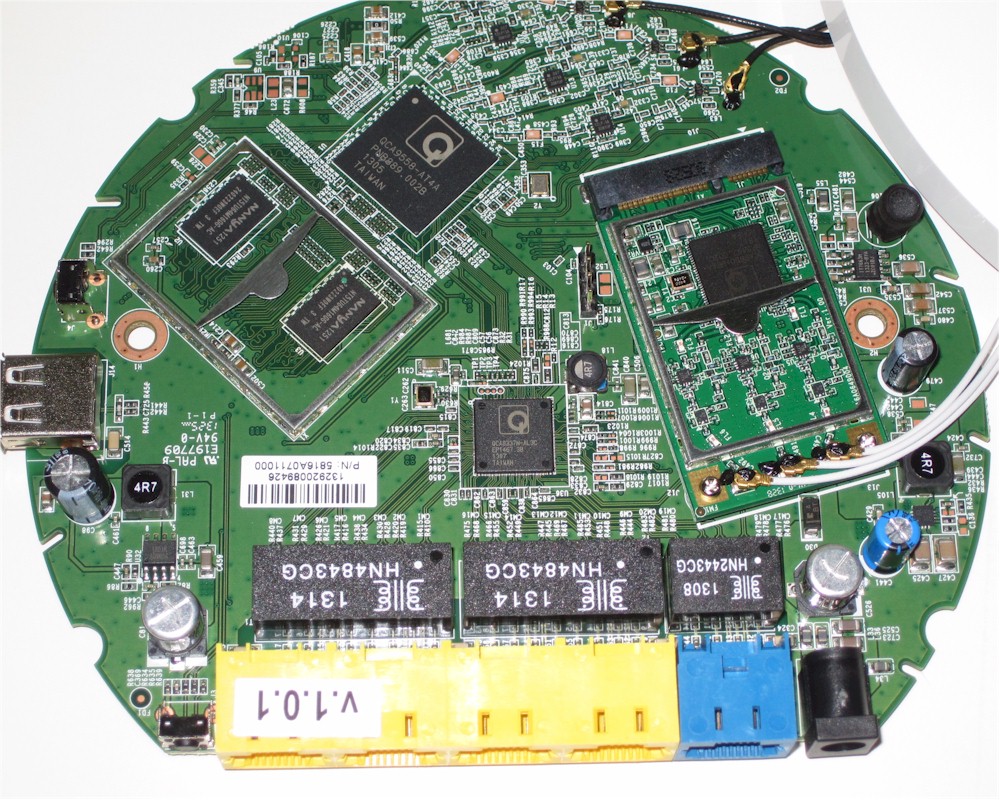
EnGenius ESR1750 board
Below is an updated summary of key components. I’ve included the ESR1200 to show the differences.
| EnGenius ESR1750 | EnGenius ESR1200 | |
|---|---|---|
| CPU | QCA9558 dual-band, 3-stream 802.11n system-on-chip | QCA9557 dual-band, 2-stream 802.11n system-on-chip |
| Switch | QCA8337 | QCA8337 |
| RAM | 128 MB | 128 MB |
| Flash | 16 MB | 16 MB |
| 2.4 GHz Radio | – In QCA9558 – SST 12LP15A 2.4 GHz power amp (x3) |
– In QCA9557 – SST 12LP15A 2.4 GHz power amp (x2) |
| 5 GHz radio | – QCA9880 Unidentified 5 GHz power amp marked 15E37TV (x3) |
– QCA9882 – Unidentified 5 GHz power amp marked 15E3WPK (x2) |
Table 1: Component summary
Storage Performance
Windows filecopy tests were run using the standard NAS testbed connected to a router Gigabit LAN port and our standard USB 3.0 drive formatted in FAT32 and NTFS connected via the USB 2.0 port.
I created this table to compare the ESR1750 file copy performance with other AC1750 class routers. I also included the EnGenius ESR1200. Both EnGenius routers turned in very similar results with relatively poor NTFS Write performance. However, both outperformed the two BCM4706-based routers (NETGEAR and ASUS) on all tests except for NTFS Write.

USB 2.0 file copy throughput comparison – MBytes/sec
Routing Performance
Routing performance for the ESR1750 loaded with 1.1.0 firmware (upgraded from 1.0.1) and using our standard test method is summarized in the table below. I also included the results for the ESR1200 for comparison. ![]()
Since both routers have the same processor, I had expected the routing performance to be almost identical. Indeed, the WAN to LAN and LAN to WAN results were virtually the same. Surprisingly, however, for the simultaneous throughput test, the ESR1750 significantly outperformed the ESR1200.
| Test Description | EnGenius ESR1750 | EnGenius ESR1200 |
|---|---|---|
| WAN – LAN | 335.3 | 333.6 |
| LAN – WAN | 322.3 | 320.3 |
| Total Simultaneous | 594.3 | 305.7 |
| Maximum Simultaneous Connections | 30,126 | 30,437 |
| Firmware Version | 1.1.0 | 1.0.1 |
Table 4: Routing throughput
The results for both the WAN to LAN and LAN to WAN tests were significantly lower than those of competing AC1750 class routers. The ESR1750 ranked 10/11 for WAN to LAN performance and 11/11 (last place) for LAN to WAN. The performance leader for WAN to LAN was the D-Link DIR-868L at 942 Mbps; for LAN to WAN, the leader was the TP-LINK Archer C7 at 942.9 Mbps. Both were running virtually at Gigabit wire speed. Still, with most consumer broadband connections running at less than 50 Mbps, the relatively low performance won’t have any noticeable impact.
For the unidirectional tests, the IxChariot chart below shows steady throughput at almost the same level. This chart is almost identical to the unidirectional chart for the ESR1200.
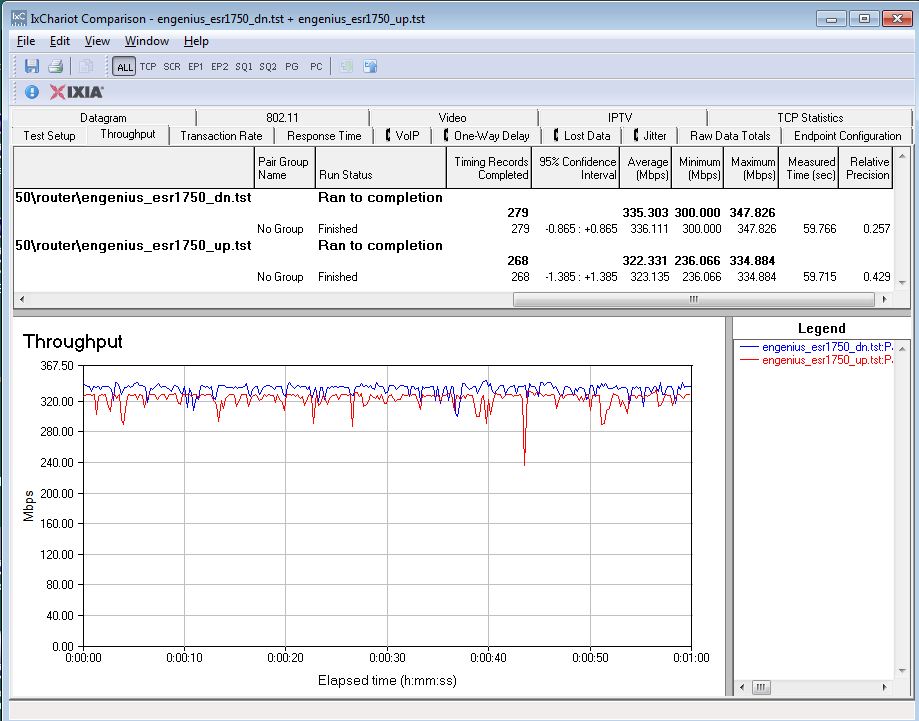
EnGenius ESR1750 routing unidirectional throughput
The story for the simultaneous up/downlink tests was quite different as compared to the ESR1200. The ESR1200 heavily favored uplink (Avg 240 Mbps) as compared to downlink (Avg 67.4 Mbps). The ESR1750 heavily favored downlink (Avg 333.3 Mbps) as compared to uplink (Avg 261.6 Mbps). Tests for both uplink and downlink showed more consistent performance with less variation.
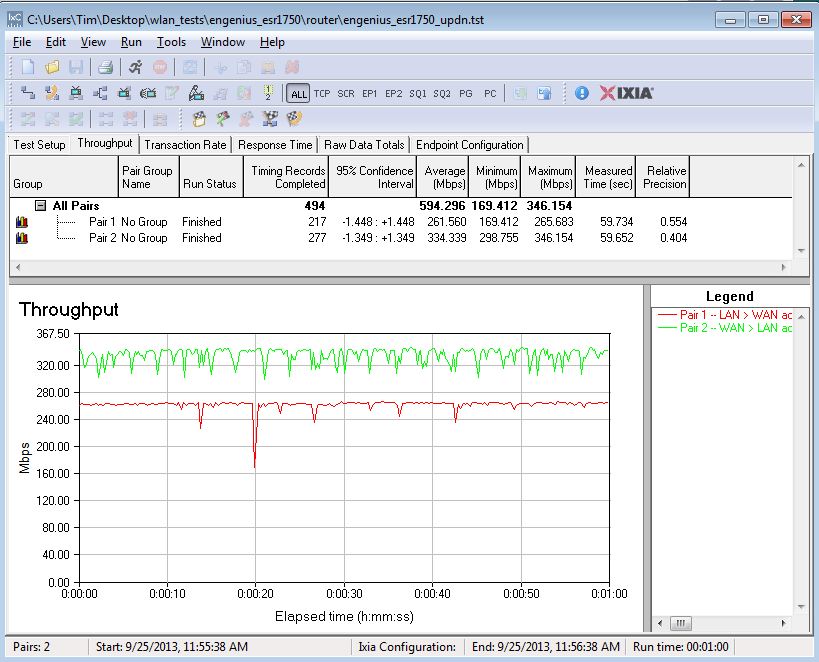
EnGenius ESR1750 routing bidirectional throughput
Part of the reason for the relatively poor routing performance is because the ESR1750 defaults the “Network Turbine” setting to off. This is the "Fast NAT" option that many current-generation routers now enable by default. Since enabling the feature on the EnGenius requires turning DLNA off and displays the ominous message below, tests weren’t run with Network Turbine enabled.
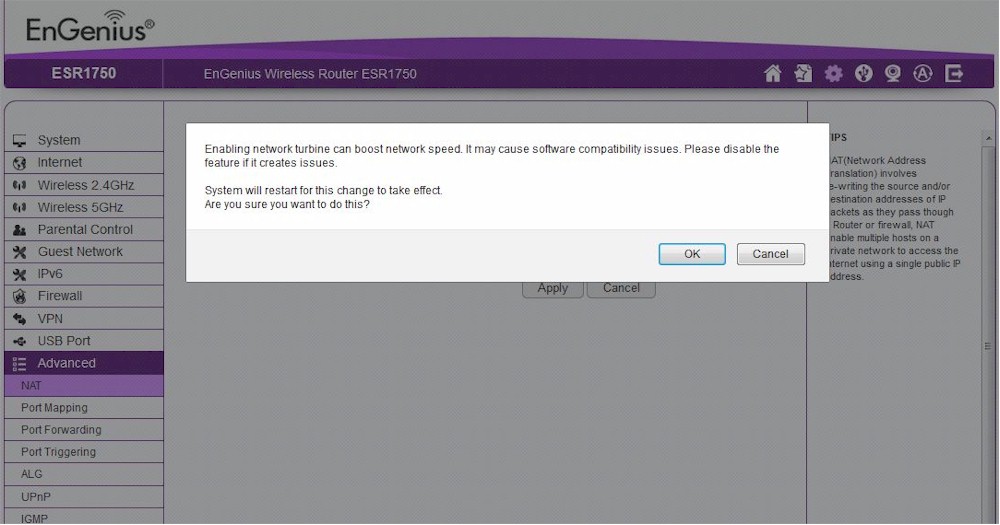
Network Turbine warning message
Wireless Performance
Like the ESR1200, the ESR1750 is not Wi-Fi Certified. It defaulted to Auto channel mode on both 2.4 and 5 GHz radios upon power-up. The 2.4 GHz radio defaulted to Auto 20/40 MHz Channel width, while the 5 GHz radio defaulted to 80 MHz. The router comes with different 2.4 and 5 GHz SSIDs set, so you’ll be able to connect to your desired band without having to change router settings.
WPS is enabled on both bands by default. Our Win 7 test client did prompt for a pushbutton session on both bands. However, it only completed a WPA2/AES connection on 2.4 GHz. On 5GHz, the WPS session would not start after pushing the button.
Both 40 MHz Coexistence and Fat channel intolerant tests failed, with the ESR1750 continuing to link at 40 MHz bandwidth rates in both cases instead of falling back to lower 20 MHz rates.
For throughput testing, all tests were run using our standard wireless test process and 1.1.0 (upgraded from 1.0.1) version firmware loaded. The router was first reset to factory defaults and Channel 6 was set for 2.4 GHz and Channel 153 for 5 GHz. 20 MHz B/W mode was set for 2.4 GHz and 5 GHz was set in 80 MHz bandwidth mode. The closest surface of the router was positioned 8″ from the chamber antennas in 0° and 180° test positions. The 0° position had the front of the router facing the chamber antennas.
The Benchmark Summary below shows the average of throughput measurements made in all test locations.
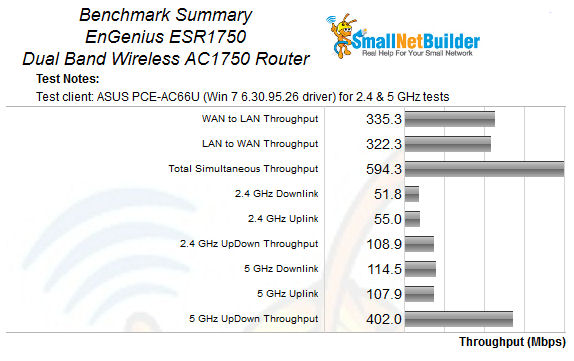
EnGenius ESR1750 Benchmark Summary
To date, we have tested 11 AC1750 class routers. For 2.4 GHz average downlink, the ESR1750’s 51.8 Mbps landed it in last place as compared to the top ranking Buffalo WZR-1750DHP at 90.8 Mbps. Similarly, for 2.4 GHz average uplink, the ESR also placed last with 55 Mbps. The top-ranking 2.4 GHz average uplink winner was the ASUS RT-AC66U at 95.3 Mbps.
For the 5 GHz tests, the ESR1750 also turned in poor average performance landing it at 10th place for both tests. In each case the 5 GHz average performance was slightly above 50% of the top-performing routers.
The Throughput vs. Attenuation plots provide a better idea about how a router is going to perform throughout its entire operating range. Tests are run with 3dB of attenuation added for each data point. More attenuation simulates more distance from the router. Routers performing well with higher attenuation are more likely to provide better coverage for your environment.
For these tests, I decided that it would be interesting to compare the ESR1750 with its AC1200 class ESR1200 sibling as well as the ASUS RT-66U and the TP-Link Archer C7 – both top-ranking AC1750 class routers.
For the 2.4 GHz downlink test, the ESR1750 actually started out with lower performance than the ESR1200 at 0dB of attenuation. From 3dB to 21 dB, it tracked pretty well with the other AC1750 routers. But at 24 dB, it started a steep dropoff to 39 dB, where it actually dropped below the ESR1200. Both EnGenius devices lost their connection at 51 dB with only the ASUS finishing the test at 63 dB of attenuation.
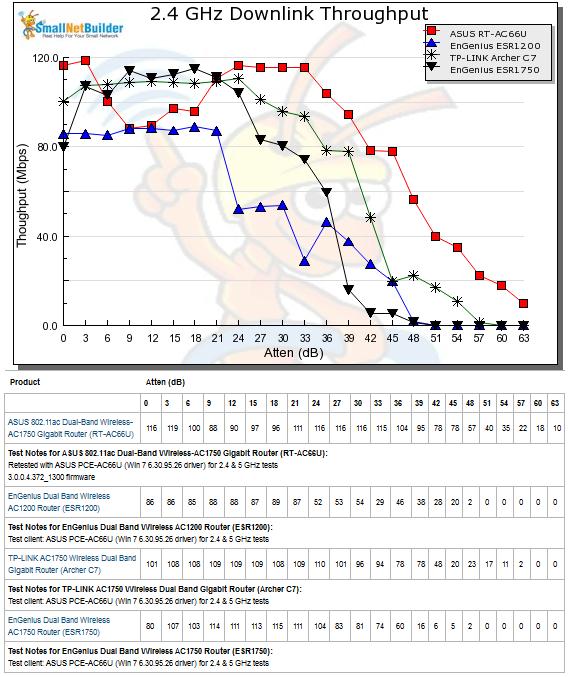
2.4 GHz Downlink Throughput vs. Attenuation
The 2.4 GHz uplink tests showed that starting at only 12 db of attenuation, performance started to drop quickly. At 18 dB, it actually dropped below the ESR1200, as well as the other two devices. It does look like EnGenius reworked their 2.4 GHz drivers, however. The ESR1750 does not show with extreme variations seen in the ESR1200. At only 33 dB of attenuation, the ESR1750 dropped below the other three and remained there until it lost connection at 51 dB. At the end of the test (63 dB), the ASUS was still getting 28 Mbps uplink throughput.
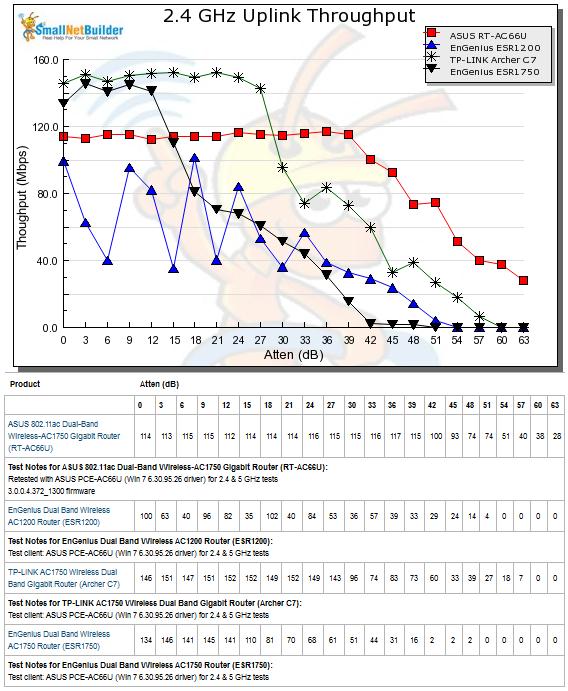
2.4 GHz Uplink Throughput vs. Attenuation
Wireless Performance – more
For the 5 GHz downlink test results, keep in mind that the ESR1750 is an AC1750 class router and the ESR1200 is an AC1200. This means that the former has a 1300 Mbps maximum 5 GHz link rate, while the latter’s link rate maxes at 867 Mbps. Both link rates were confirmed during testing. Despite the different link rates, however, the 5 GHz performance of the two routers was remarkably similar.
In the plot below, the ESR1750 tracked the ESR1200 at a slightly higher level, but still well below the ASUS and the TP-Link devices. Where as the ESR1200 lost its connection at 36 dB, the ESR1750 held onto its connection through 42 dB. Both the TP-Link and the ASUS both held their connections throughout the test range turning in 58 Mbps and 55 Mbps respectively at 45 dB of attenuation.
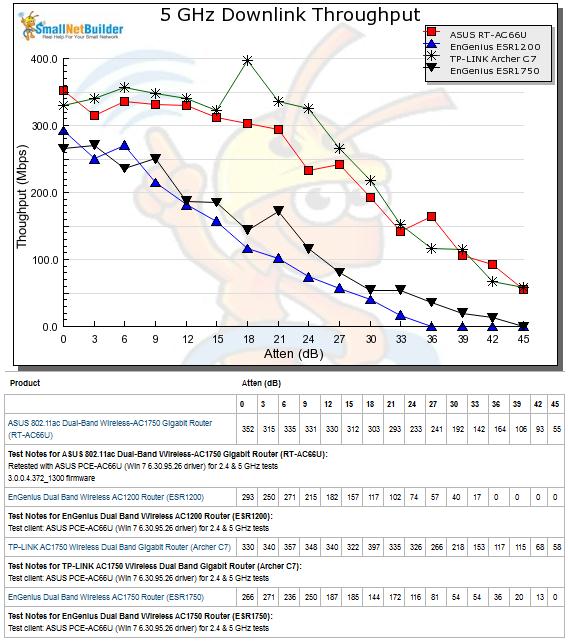
5 GHz Downlink Throughput vs. Attenuation
Finally, for the 5 GHz uplink tests, you’ll note that the ESR1750 tracked the performance of the ESR1200 very closely throughout much of the range. As with the 5 GHz downlink tests, the ESR1200 dropped its connection at 36 dB with the ESR1750 failing at 45 dB. It’s interesting to note that at 18 dB of attenuation and above, the TP-LINK significantly outperformed the ASUS completing the test while still getting an amazing 105 Mbps of uplink throughput.
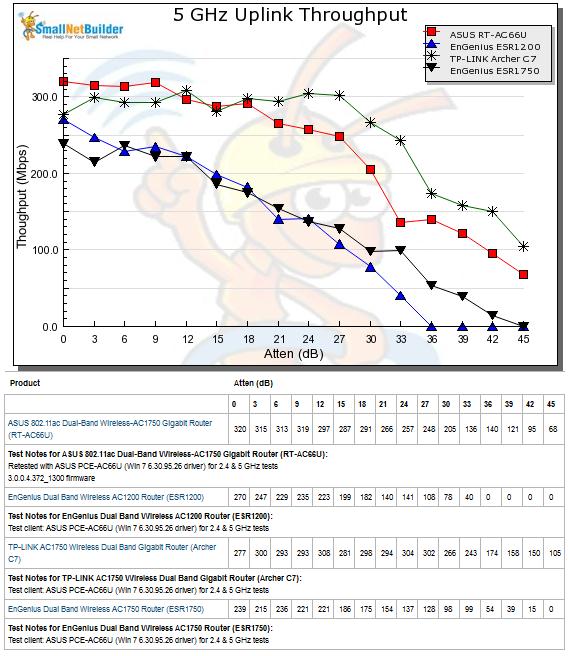
5 GHz Uplink Throughput vs. Attenuation
Closing Thoughts
While the Router Ranker for AC1750 class router shows that the EnGenius ESR1750 ranks as number 8 for Total Router, that’s actually last place because there was a tie for #3 (Western Digital WDBNWNJ0000NBL and D-Link DIR-868L) as well as a tie for #4 (NETGEAR R6300 and Linksys EA6500).
If you check the sub-rankings (Routing Throughput, Average Wireless Throughput, Maximum Wireless Throughput and Wireless Range), you’ll find that the ESR1750 is at or near the bottom of each of those as well. The Router Ranker just confirms what all of the tables, plots and charts were telling us—the ESR1750 just isn’t a great performing router.
If you sort the Router Ranker by price, the ESR1750 comes at the fourth least expensive router AC1750 router at $140. But the cheapest router, the confusingly-named $105 Western Digital MyNet AC1300, has a Total Router ranking of #3. The next most expensive router is the $120 Linksys EA6500 with a ranking of #4.
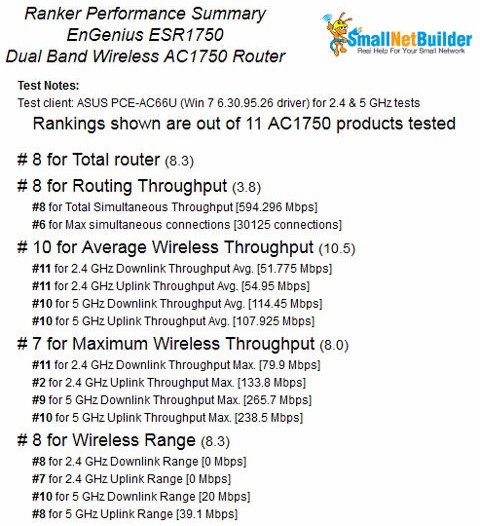
EnGenius ESR1750 Ranking Performance Summary
For the ESR1750, I’ve reached the same conclusion as Scott did in his review of the EnGenius ESR1200. Unless you’re looking for a realtively inexpensive router with VPN server capabilities, there’s no compelling reason to buy the ESR1750. There are better performing routers below the ESR1750’s price point and much better performing routers at higher price points. And if for some reason you want an EnGenius, the $20 cheaper ESR1200 will save you a little bit and deliver essentially the same 5 GHz AC performance.
